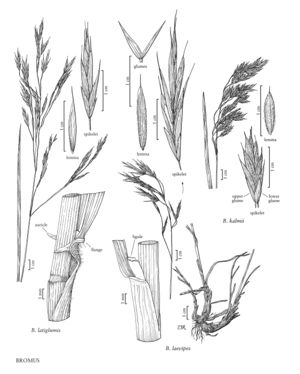Difference between revisions of "Bromus latiglumis"
FNA>Volume Importer |
FNA>Volume Importer |
||
| Line 8: | Line 8: | ||
|name=Bromus purgans var. latiglumis | |name=Bromus purgans var. latiglumis | ||
|authority=unknown | |authority=unknown | ||
| − | }}{{Treatment/ID/Synonym | + | }} {{Treatment/ID/Synonym |
|name=Incanus | |name=Incanus | ||
|authority=unknown | |authority=unknown | ||
| − | }}{{Treatment/ID/Synonym | + | }} {{Treatment/ID/Synonym |
|name=Incanus | |name=Incanus | ||
|authority=unknown | |authority=unknown | ||
| − | }}{{Treatment/ID/Synonym | + | }} {{Treatment/ID/Synonym |
|name=Bromus altissimus | |name=Bromus altissimus | ||
|authority=unknown | |authority=unknown | ||
| Line 29: | Line 29: | ||
-->{{Treatment/Body | -->{{Treatment/Body | ||
|distribution=Conn.;N.J.;N.Y.;Del.;D.C;Wis.;W.Va.;Kans.;N.Dak.;Nebr.;S.Dak.;N.H.;N.C.;Pa.;Alta.;B.C.;Man.;N.B.;Ont.;Que.;Sask.;Va.;Vt.;Ill.;Ind.;Iowa;Maine;Md.;Mass.;Ohio;Mo.;Minn.;Mich.;Mont.;Tenn.;Ky. | |distribution=Conn.;N.J.;N.Y.;Del.;D.C;Wis.;W.Va.;Kans.;N.Dak.;Nebr.;S.Dak.;N.H.;N.C.;Pa.;Alta.;B.C.;Man.;N.B.;Ont.;Que.;Sask.;Va.;Vt.;Ill.;Ind.;Iowa;Maine;Md.;Mass.;Ohio;Mo.;Minn.;Mich.;Mont.;Tenn.;Ky. | ||
| − | |discussion=<p>Bromus latiglumis grows in shaded or open woods, along stream banks, and on alluvial plains and slopes. Its range is mainly in the north-central and northeastern United States and adjacent Canadian provinces. Specimens with decumbent, weak, sprawling culms, densely hairy sheaths, and heavy panicles can be called Bromus latiglumis i. incanus (Shear) Fernald.</p> | + | |discussion=<p><i>Bromus latiglumis</i> grows in shaded or open woods, along stream banks, and on alluvial plains and slopes. Its range is mainly in the north-central and northeastern United States and adjacent Canadian provinces. Specimens with decumbent, weak, sprawling culms, densely hairy sheaths, and heavy panicles can be called <i>Bromus latiglumis</i> i. incanus (Shear) Fernald.</p> |
|tables= | |tables= | ||
|references= | |references= | ||
| Line 50: | Line 50: | ||
|publication year= | |publication year= | ||
|special status= | |special status= | ||
| − | |source xml=https://jpend@bitbucket.org/aafc-mbb/fna-data-curation.git/src/ | + | |source xml=https://jpend@bitbucket.org/aafc-mbb/fna-data-curation.git/src/8f726806613d60c220dc4493de13607dd3150896/coarse_grained_fna_xml/V24/V24_290.xml |
|subfamily=Poaceae subfam. Pooideae | |subfamily=Poaceae subfam. Pooideae | ||
|tribe=Poaceae tribe Bromeae | |tribe=Poaceae tribe Bromeae | ||
Revision as of 17:18, 18 September 2019
Plants perennial; not rhizomatous. Culms 80-150 cm, erect; nodes 9-20, glabrous, usually concealed by the leaf sheaths; internodes usually glabrous, sometimes hairy just below the nodes. Sheaths overlapping, densely to moderately retrorsely pilose or glabrous over most of their surface, throats and collars densely pilose; auricles 1-2.5 mm on most lower leaves; ligules 0.8-1.4 mm, hirsute, ciliate, truncate, erose; blades 20-30 cm long, 5-15 mm wide, flat, usually glabrous, rarely pilose, with 2 prominent flanges at the collar. Panicles 10-22 cm, open, nodding; branches spreading to ascending. Spikelets 15-30 mm, elliptic to lanceolate, terete to moderately laterally compressed, with 4-9 florets. Glumes pubescent or glabrous; lower glumes 4-7.5 mm, 1(3)-veined; upper glumes 6-9 mm, 3-veined, sometimes mucronate; lemmas 8-14 mm, elliptic to lanceolate, rounded over the midvein, backs glabrous or pilose to pubescent, margins long-pilose, apices obtuse to acute, entire; awns 3-4.5(7) mm, straight, arising less than 1.5 mm below the lemma apices; anthers 2-3 mm. 2n = 14.
Distribution
Conn., N.J., N.Y., Del., D.C, Wis., W.Va., Kans., N.Dak., Nebr., S.Dak., N.H., N.C., Pa., Alta., B.C., Man., N.B., Ont., Que., Sask., Va., Vt., Ill., Ind., Iowa, Maine, Md., Mass., Ohio, Mo., Minn., Mich., Mont., Tenn., Ky.
Discussion
Bromus latiglumis grows in shaded or open woods, along stream banks, and on alluvial plains and slopes. Its range is mainly in the north-central and northeastern United States and adjacent Canadian provinces. Specimens with decumbent, weak, sprawling culms, densely hairy sheaths, and heavy panicles can be called Bromus latiglumis i. incanus (Shear) Fernald.
Selected References
None.
